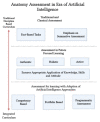Teaching, Learning and Assessing Anatomy with Artificial Intelligence: The Road to a Better Future
- PMID: 36361089
- PMCID: PMC9656803
- DOI: 10.3390/ijerph192114209
Teaching, Learning and Assessing Anatomy with Artificial Intelligence: The Road to a Better Future
Abstract
Anatomy is taught in the early years of an undergraduate medical curriculum. The subject is volatile and of voluminous content, given the complex nature of the human body. Students frequently face learning constraints in these fledgling years of medical education, often resulting in a spiraling dwindling academic performance. Hence, there have been continued efforts directed at developing new curricula and incorporating new methods of teaching, learning and assessment that are aimed at logical learning and long-term retention of anatomical knowledge, which is a mainstay of all medical practice. In recent years, artificial intelligence (AI) has gained in popularity. AI uses machine learning models to store, compute, analyze and even augment huge amounts of data to be retrieved when needed, while simultaneously the machine itself can be programmed for deep learning, improving its own efficiency through complex neural networks. There are numerous specific benefits to incorporating AI in education, which include in-depth learning, storage of large electronic data, teaching from remote locations, engagement of fewer personnel in teaching, quick feedback from responders, innovative assessment methods and user-friendly alternatives. AI has long been a part of medical diagnostics and treatment planning. Extensive literature is available on uses of AI in clinical settings, e.g., in Radiology, but to the best of our knowledge there is a paucity of published data on AI used for teaching, learning and assessment in anatomy. In the present review, we highlight recent novel and advanced AI techniques such as Artificial Neural Networks (ANN), or more complex Convoluted Neural Networks (CNN) and Bayesian U-Net, which are used for teaching anatomy. We also address the main advantages and limitations of the use of AI in medical education and lessons learnt from AI application during the COVID-19 pandemic. In the future, studies with AI in anatomy education could be advantageous for both students to develop professional expertise and for instructors to develop improved teaching methods for this vast and complex subject, especially with the increasing paucity of cadavers in many medical schools. We also suggest some novel examples of how AI could be incorporated to deliver augmented reality experiences, especially with reference to complex regions in the human body, such as neural pathways in the brain, complex developmental processes in the embryo or in complicated miniature regions such as the middle and inner ear. AI can change the face of assessment techniques and broaden their dimensions to suit individual learners.
Keywords: anatomy; artificial intelligence; assessment; computer-aided; learning; machine learning; medicine; technology.
Conflict of interest statement
The authors declare no conflict of interest.
Figures
References
-
- Vesalius A. De Humani Corporis Fabrica. Oporinus; Basel, Switzerland: 1543.
-
- Pabst R., Rothkotter H.J. Retrospective evaluation of under-graduate medical education by doctors at the end of their residency time in hospitals: Consequences for the anatomical curriculum. Anat. Rec. 1997;249:431–434. doi: 10.1002/(SICI)1097-0185(199712)249:4<431::AID-AR1>3.0.CO;2-U. - DOI - PubMed
Publication types
MeSH terms
LinkOut - more resources
Full Text Sources
Medical





